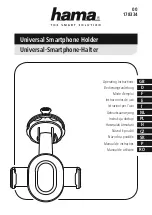
189
APPENDIX
established by the government adopted requirement for safe
exposure. The tests are performed in positions and locations (e.g., at
the ear and worn on the body) as required by the FCC for each model.
The highest SAR value for this model phone when tested for use
at the ear is 0.626 W/Kg and when worn on the body, as described
in this user guide, is 0.886 W/Kg. (Body-worn measurements differ
among phone models, depending upon available accessories and
FCC requirements.) While there may be differences between the SAR
levels of various phones and at various positions, they all meet the
government requirement for safe exposure.
The SAR testing for Body-worn operation was performed with a belt
clip that provided a 1cm separation. The User’s Manual indicates that
any holsters/clips used with this device should contain no metallic
components.
The FCC has granted an Equipment Authorization for this model
phone with all reported SAR levels evaluated as in compliance with
the FCC RF exposure guidelines.
SAR information on this model phone is on file with the FCC and can
be found under the Display Grant section of http://www.fcc.gov/oet/
ea after searching on JYCSTARQ.
Additional information on Specific Absorption Rates (SAR) can be
found on the Cellular Telecommunications Industry Association (CTIA)
web-site at http://www.ctia.org.
* In the United States and Canada, the SAR limit for mobile phones
used by the public is 1.6 watts/kg (W/kg) averaged over one gram of
tissue. The standard incorporates a substantial margin of safety to give
additional protection for the public and to account for any variations
in measurements.
















































